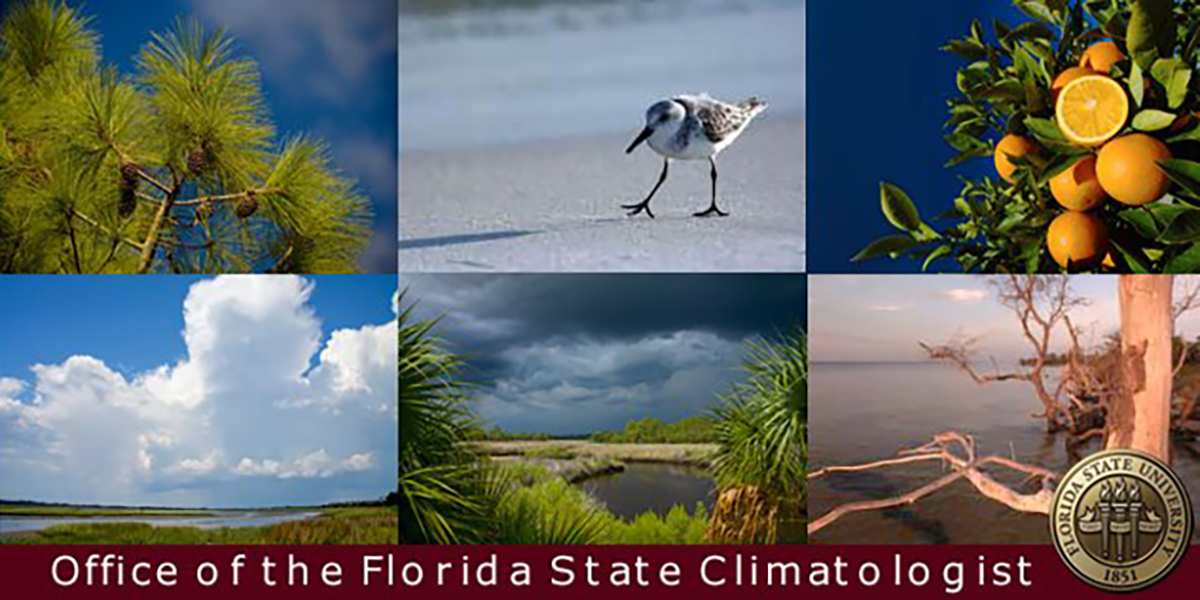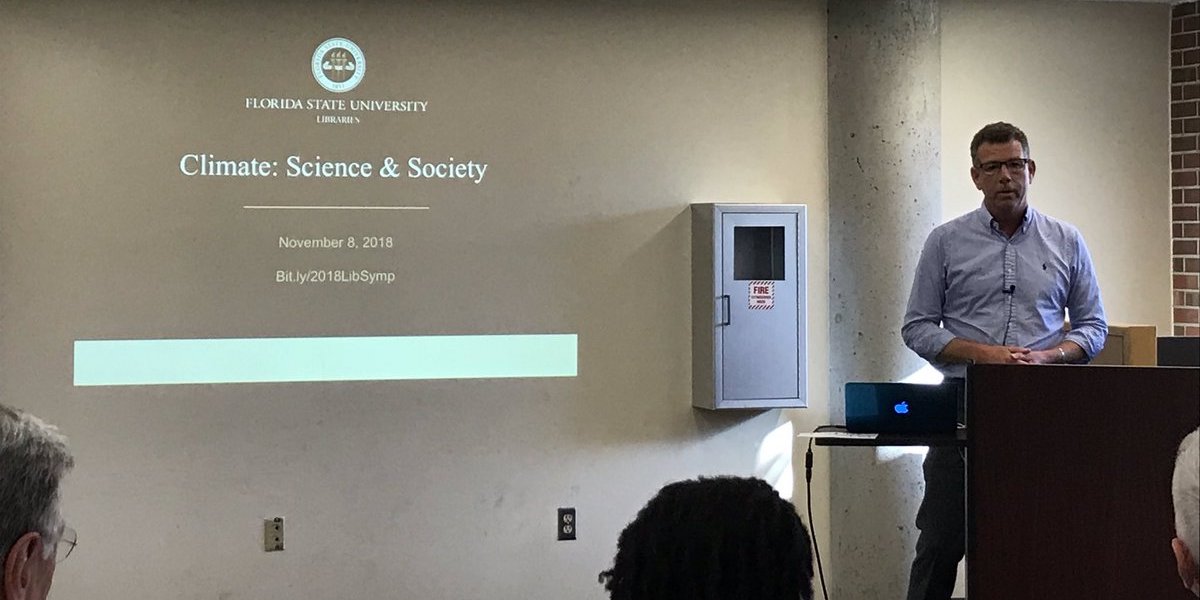The Florida Climate Center serves as the primary resource for climate data, information, and services in the state of Florida.
What's new in our world?
The Florida Climate Center achieves its mission by providing climate monitoring, research, and expertise to be applied by the people, institutions, and businesses of Florida and the surrounding region.
We provide direct service by fulfilling requests for climate and weather data and information in a variety of formats.
We perform research that advances the understanding of the climate variability and changes of Florida and the surrounding region.
We provide outreach in presentations and at events aimed at a variety of groups, interests, and ages.
Prepared by Florida Climate Center
The Florida State University
Tallahassee, FL
Average temperatures in February were on average 3 ̊F warmer than historical averages across the state. Average temperatures were at or near normal across northern Florida and the Panhandle and much above normal across the Florida Peninsula. Average temperatures for the month ranged from +5.8 ̊F in West Palm Beach to +0.2 ̊F in Pensacola (see Table 1 and Appendix 1 for select cities). West Palm Beach experienced its third warmest February on record, and Fort Lauderdale had its fourth warmest February on record. Many daily high maximum and high minimum temperature records were set during the month (see Appendices 2 and 3).
Table 1. February average temperatures and departures from normal ( ̊F) for selected cities.
| Station | Mean Temperature | Departure from Normal |
| Pensacola | 54.9 | +0.2 |
| Tallahassee | 56.6 | +1.9 |
| Jacksonville | 57.9 | +1.5 |
| Orlando | 67.1 | +4.1 |
| Tampa | 67.3 | +3.9 |
| Miami | 74.5 | +4.3 |
| Key West | 74.8 | +3.8 |
Rainfall totals in February were variable across the state with some locations receiving above normal rainfall and other locations with near or below normal rainfall. Monthly departures from normal ranged from -1.3 inches in Tallahassee to +3.4 inches in Jacksonville (Table 2 and Appendix 1). Much of the northern Peninsula and parts of the Panhandle had above normal rainfall while southwestern Florida experienced below normal rainfall throughout the month (Figure 1). No monthly rainfall records were set during the month. Vero Beach had its third wettest February on record and Jacksonville had its fourth wettest February on record.
Table 2. February precipitation totals and departures from normal (inches) for selected cities.
| Station | Total Rainfall | Departure from Normal |
| Pensacola | 3.85 | -1.21 |
| Tallahassee | 3.58 | -1.27 |
| Jacksonville | 6.63 | +3.44 |
| Orlando | 2.38 | 0.0 |
| Tampa | 3.74 | +0.93 |
| Miami | 2.90 | +0.65 |
| Key West | 0.69 | -0.8 |
Figure 1. A graphical depiction of the monthly rainfall departure from normal (inches) for February (courtesy of NOAA, NWS).
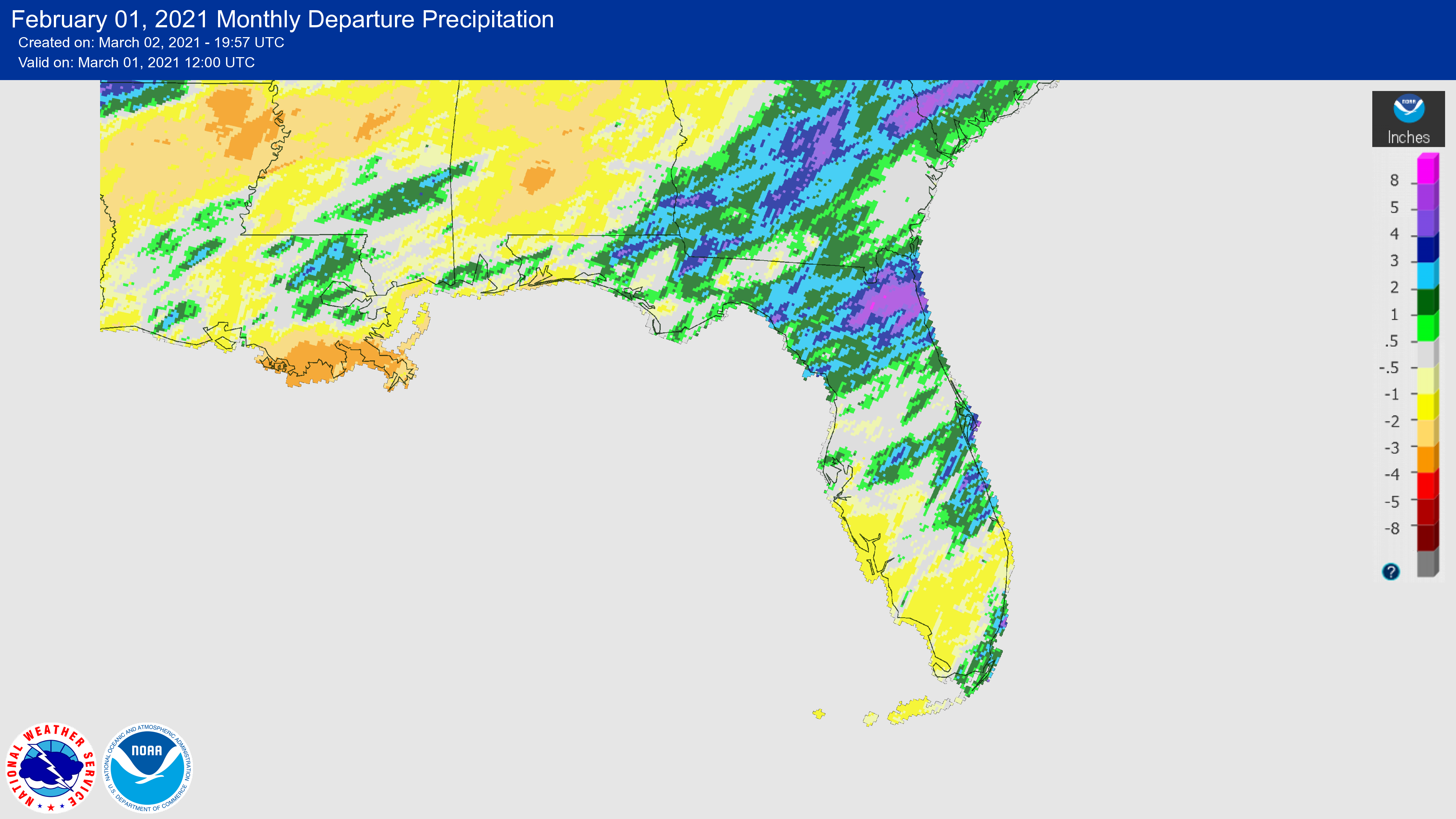
La Niña Conditions in the Pacific Persisted.
La Niña conditions continued during February, but forecasters estimate a shift to ENSO-neutral conditions this spring (~60% chance for April-June). ENSO-neutral conditions are then expected to continue at least through the Northern Hemisphere summer. Recent stratospheric warming and disruptions in the polar vortex, along with a negative phase in the Arctic Oscillation, have influenced weather patterns in the eastern U.S. this winter and overwhelmed typical weather patterns generally seen during La Niña. However, more typical La Niña conditions have returned with above-average temperatures and drier than average conditions across much of the southern tier of the U.S.
Hazardous Weather Events in February.
According to the Local Storm Reports issued by the local National Weather Service offices serving Florida, there were 249 individual local reports of hazardous weather events recorded across the state during the month of February (see Table 4 for a breakdown by event type).
Table 4. Breakdown of storm reports submitted in Florida during the month of February (compiled from Iowa State University/Iowa Environmental Mesonet).
| Report Type | Number of Reports |
| Marine Thunderstorm Wind | 24 |
| Non-Thunderstorm Wind Damage | 1 |
| Non-Thunderstorm Wind Gust | 55 |
| Tornado/Waterspout/Funnel Cloud | 6/1/5 |
| Thunderstorm Wind Damage | 41 |
| Thunderstorm Wind Gust | 54 |
| Lightning | 3 |
| Hail | 31 |
| Flood/FLash Flood | 9/1 |
| Heavy Rain | 17 |
| Rip Currents | 1 |
Drought-Related Impacts.
Near the end of February 2021, abnormally dry conditions were found in parts of the Florida Peninsula and the extreme western panhandle region. According to the U.S. Drought Monitor, 33 percent of the state was in abnormally dry conditions (D0) at the end of the month. In early February, abnormally dry conditions emerged across much of the Florida Peninsula but by mid-February these conditions dissipated in some areas. Dry conditions are expected to continue, and the seasonal drought outlook indicates that drought development is likely through the spring across the Peninsula.
As of February 28, the Lake Okeechobee water level was at 15.33 ft. above sea level (Feet-NGVD29), which is above average for this time of the year. At the first of the month, the water level was 15.51 ft. above sea level.
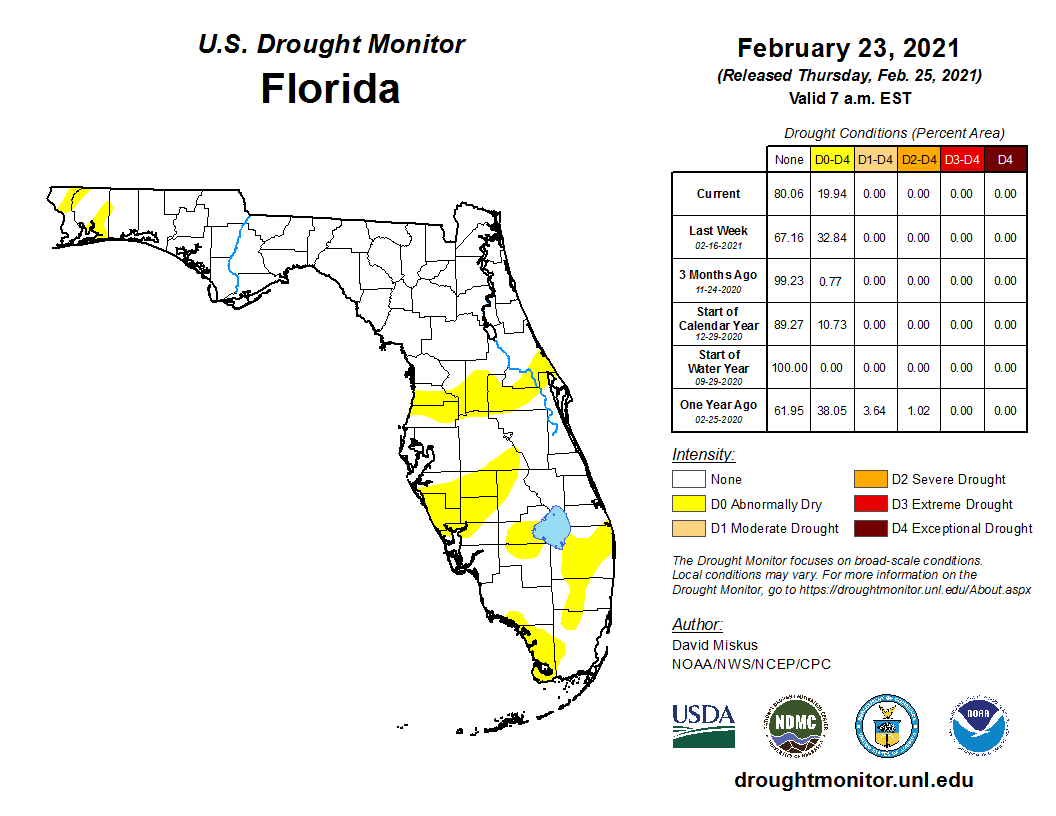
Agriculture-Related Impacts.
For the month of February, the Crop Progress - State Stories, produced monthly December through March, for Florida indicates that pasture conditions declined at the beginning of February due to colder temperatures but improved throughout the month as temperatures rose. Cattle conditions remained mostly good during the month, while sugarcane had minimal damage from frost that was reported mid-month. Toward the end of the month, powdery mildew and worm pressure were reported in some crops. Many citrus fruits were harvested, and several vegetable crops came to market.
Appendix 1
Additional February departures from normal data for select Florida locations (Source: NWS).
| Station | Average Temperature (˚F) | Departure from Normal (˚F) | Total Rainfall (in.) | Departure from Normal (in.) |
| Gainesville | 60.5 | +3.0 | 6.01 | +2.81 |
| Sarasota | 67.6 | +4.2 | 2.19 | -0.51 |
| Melbourne | 68.1 | +5.4 | 2.61 | +0.08 |
| Fort Myers | 70.8 | +4.2 | 2.98 | +0.83 |
| West Palm Beach | 73.6 | +5.8 | 2.62 | -0.20 |
Appendix 2
Select daily record high maximum temperatures tied or broken during February (compiled from NOAA).
| Location | Date | Record (˚F) | Broken/Tied | Last |
| Fort Lauderdale | 8 | 84 | Tied | 84 in 2020 |
| Punta Gorda | 9 | 89 | Broken | 87 in 2017 |
| Orlando | 9 | 86 | Broken | 84 in 1994 |
| West Palm Beach | 9 | 85 | Tied | 85 in 2017 |
| Clermont | 10 | 87 | Broken | 85 in 2001 |
| Tampa | 10 | 86 | Broken | 85 in 2020 |
| Orlando | 10 | 86 | Broken | 85 in 2018 |
| Clermont | 11 | 88 | Broken | 87 in 2018 |
| Miles City | 12 | 90 | Tied | 90 in 2020 |
| Vero Beach | 13 | 88 | Broken | 87 in 2020 |
| Lakeland | 13 | 84 | Tied | 84 in 1959 |
| Vero Beach | 14 | 88 | Broken | 87 in 2009 |
| Perrine | 15 | 87 | Broken | 86 in 2020 |
| Plant City | 15 | 89 | Broken | 88 in 1959 |
| Punta Gorda | 15 | 88 | Broken | 87 in 2003 |
| Tampa | 15 | 86 | Broken | 85 in 1990 |
| Ochopee | 15 | 87 | Tied | 87 in 2003 |
| Daytona Beach | 15 | 86 | Broken | 85 in 1959 |
| Miami | 15 | 86 | Broken | 84 in 2017 |
| Melbourne | 16 | 88 | Broken | 87 in 1982 |
| Sanford | 16 | 87 | Broken | 85 in 2001 |
| Punta Gorda | 17 | 87 | Tied | 87 in 2020 |
| Tarpon Springs | 18 | 85 | Tied | 85 in 2020 |
| Mayport | 18 | 87 | Broken | 85 in 2019 |
| Daytona Beach | 18 | 88 | Broken | 87 in 1944 |
| Lisbon | 19 | 85 | Broken | 84 in 2019 |
| Sanford | 20 | 88 | Broken | 85 in 2019 |
| Vero Beach | 20 | 88 | Broken | 87 in 1975 |
| Tampa | 26 | 87 | Broken | 85 in 1997 |
| Plant City | 27 | 90 | Broken | 89 in 1962 |
| Pensacola | 28 | 79 | Broken | 78 in 2018 |
Appendix 3
Select daily record high minimum temperatures tied or broken during February (compiled from NOAA).
| Location | Date | Record (˚F) | Broken/Tied | Last |
| Clermont | 7 | 69 | Broken | 67 in 1955 |
| Perrine | 7 | 70 | Broken | 68 in 2018 |
| Punta Gorda | 7 | 71 | Broken | 65 in 1971 |
| Lakeland | 7 | 68 | Broken | 66 in 1955 |
| Mountain Lake | 8 | 70 | Broken | 68 in 2018 |
| Vero Beach | 8 | 67 | Broken | 65 in 2008 |
| Fort Pierce | 9 | 69 | Tied | 69 in 1939 |
| Orlando | 9 | 67 | Broken | 64 in 1965 |
| Bradenton | 10 | 66 | Tied | 66 in 1982 |
| Miles City | 10 | 67 | Broken | 66 in 1982 |
| Orlando | 10 | 67 | Broken | 65 in 2019 |
| Bradenton | 13 | 69 | Tied | 69 in 2018 |
| Perrine | 14 | 71 | Broken | 69 in 1997 |
| Miami | 14 | 76 | Broken | 74 in 1997 |
| Fort Lauderdale Beach | 15 | 75 | Broken | 72 in 2018 |
| Tampa | 15 | 66 | Broken | 64 in 2018 |
| Stuart | 16 | 75 | Broken | 73 in 2020 |
| Fort Lauderdale | 18 | 73 | Broken | 71 in 1995 |
| Perrine | 18 | 71 | Broken | 68 in 2008 |
| Daytona Beach | 19 | 70 | Broken | 66 in 2020 |
| Hastings | 19 | 67 | Broken | 64 in 1994 |
| Titusville | 19 | 70 | Broken | 68 in 2020 |
| Mountain Lake | 22 | 78 | Broken | 70 in 2014 |
| Tampa | 27 | 70 | Broken | 69 in 1997 |
Prepared by Florida Climate Center
The Florida State University
Tallahassee, FL
March Key Points:
- Temperatures were above normal, while rainfall was below normal across Florida.
- Abnormally dry conditions developed over peninsular Florida, and moderate drought developed in parts of the southern Peninsula by the end of the month.
- La Niña Advisory continues but appears to be weakening.
- CPC seasonal forecast favors above normal temperatures and equal chances of rainfall for spring.
- Drought development continues to be a risk as temperatures warm during spring with seasonal reduction in rainfall, especially over peninsular Florida.
Average temperatures in March were above normal across the state. Average temperatures ranged from +1.7 ̊F to +4.8 ̊F above normal for the month (see Table 1 and Appendix 1 for select cities). Temperatures were especially warm during the middle and latter parts of the month, with summer-like temperatures observed in many locations. For instance, in Pensacola daily high temperatures averaged 8.8 ̊F above normal and daily low temperatures averaged 12.2 ̊F above normal from March 12-17. Jacksonville Beach observed its fifth warmest March on record, and Pensacola observed its seventh warmest March on record. Many daily high maximum and high minimum temperature records were set during the month (see Appendices 2 and 3).
Table 1. March average temperatures and departures from normal ( ̊F) for selected cities.
| Station | Mean Temperature | Departure from Normal |
| Pensacola | 65.2 | +4.8 |
| Tallahassee | 63.9 | +3.5 |
| Jacksonville | 63.6 | +1.9 |
| Orlando | 69.4 | +2.5 |
| Tampa | 70.9 | +3.6 |
| Miami | 74.5 | +1.9 |
| Key West | 76.0 | +2.8 |
Rainfall totals in March were below normal across the state. Most of the Panhandle and peninsular Florida had below normal rainfall, with the exception of a few isolated locations in the western Panhandle and north central Florida (Figure 1). Monthly departures from normal ranged from -1.13 inches in Miami to -4.11 inches in Tallahassee (Table 2 and Appendix 1). Homestead observed its driest March on record, with a recorded 0.07 inches of rainfall during the month. Lakeland had its second driest March on record, and Key West had its third driest March on record.
Table 2. March precipitation totals and departures from normal (inches) for selected cities.
| Station | Total Rainfall | Departure from Normal |
| Pensacola | 4.55 | -1.26 |
| Tallahassee | 1.83 | -4.11 |
| Jacksonville | 2.82 | -1.13 |
| Orlando | 2.03 | -1.74 |
| Tampa | 1.07 | -1.96 |
| Miami | 1.87 | -1.13 |
| Key West | 0.05 | -2.0 |
Figure 1. A graphical depiction of the monthly rainfall departure from normal (inches) for March (courtesy of NOAA, NWS).
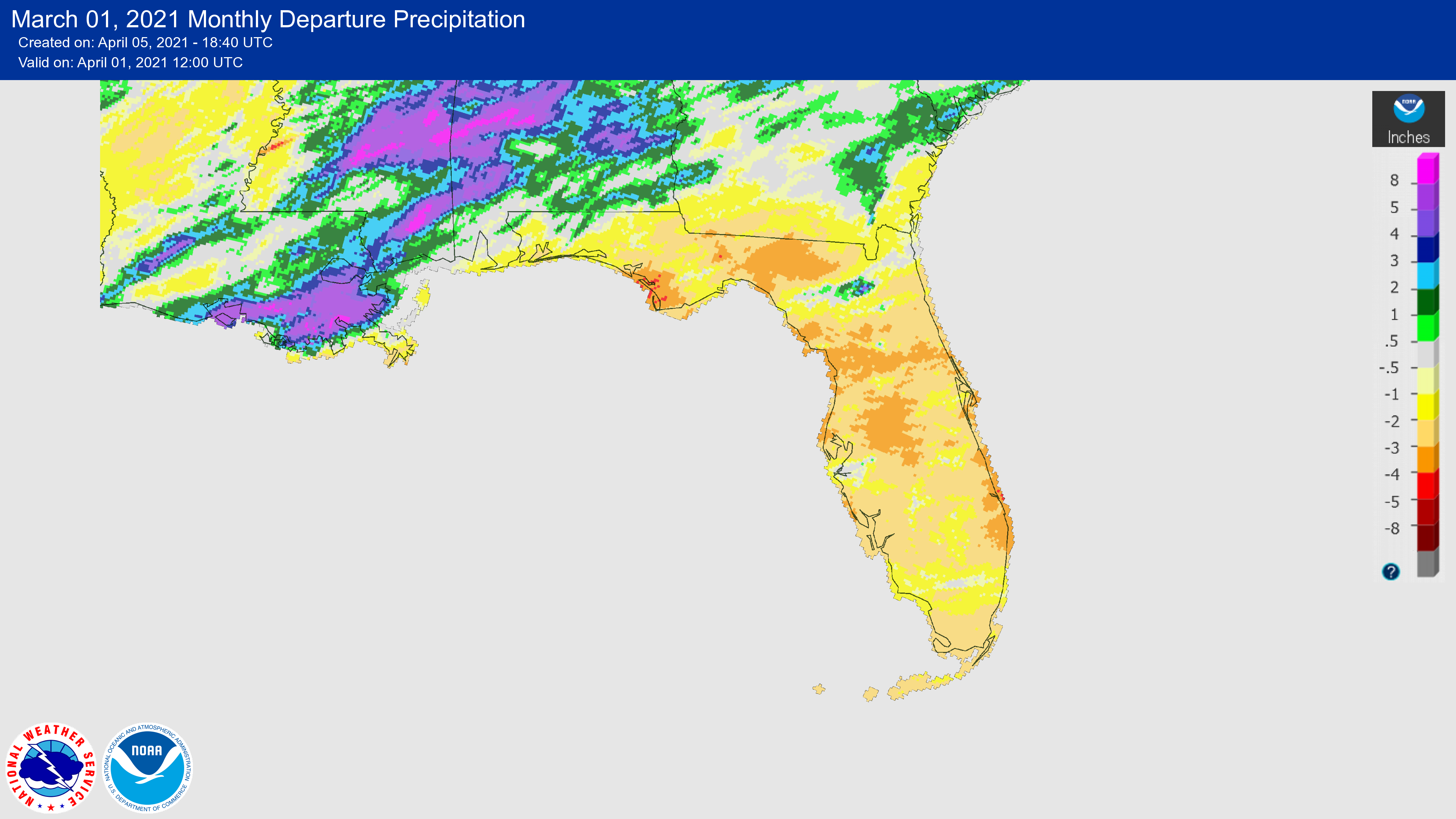
La Niña Conditions in the Pacific Continue but Weaken.
La Niña conditions continued during March but it has weakened recently, and forecasters estimate a shift to ENSO-neutral conditions this spring (~60% chance for April-June). ENSO-neutral conditions are then expected to continue at least through the Northern Hemisphere summer. La Niña conditions have returned with above-average temperatures and drier than average conditions across much of the southern tier of the U.S.
Hazardous Weather Events in March.
According to the Local Storm Reports issued by the local National Weather Service offices serving Florida, there were 127 individual local reports of hazardous weather events recorded across the state during the month of March (see Table 4 for a breakdown by event type). A wildfire was reported on March 16th in Big Cypress National Preserve, with portions of the preserve closed to the public and smoke possibly causing issues on HWY 41 and SR 29. Strong rip currents at Miramar Beach and Miami Beach resulted in multiple rescues and three fatalities during the month.
Table 4. Breakdown of storm reports submitted in Florida during the month of March (compiled from Iowa State University/Iowa Environmental Mesonet).
| Report Type | Number of Reports |
| Marine Thunderstorm Wind | 6 |
| Non-Thunderstorm Wind Damage | 2 |
| Non-Thunderstorm Wind Gust | 42 |
| Tornado/Waterspout/Funnel Cloud | 6/4/0 |
| Thunderstorm Wind Damage | 14 |
| Thunderstorm Wind Gust | 17 |
| Hail | 15 |
| Flood/FLash Flood | 1/0 |
| Heavy Rain | 17 |
| Rip Currents | 2 |
| Wildfire | 1 |
Drought-Related Impacts.
By the end of March 2021, abnormally dry conditions were widespread across the Florida Peninsula and parts of the southern Peninsula were in moderate drought. In early to mid-March, abnormally dry conditions existed across much of the Florida Peninsula and the western Panhandle regions. By the end of the month, pockets of moderate drought had formed in extreme southwestern Florida and southeast Florida. According to the U.S. Drought Monitor, 46 percent of the state was in abnormally dry conditions (D0) and 2 percent in moderate drought (D1) by the end of the month. Dry conditions are expected to continue, and the seasonal drought outlook indicates that drought development is likely through the spring across the Peninsula.
As of March 31, the Lake Okeechobee water level was at 14.44 ft. above sea level (Feet-NGVD29), which is right about average for this time of the year. At the first of the month, the water level was 15.32 ft. above sea level.
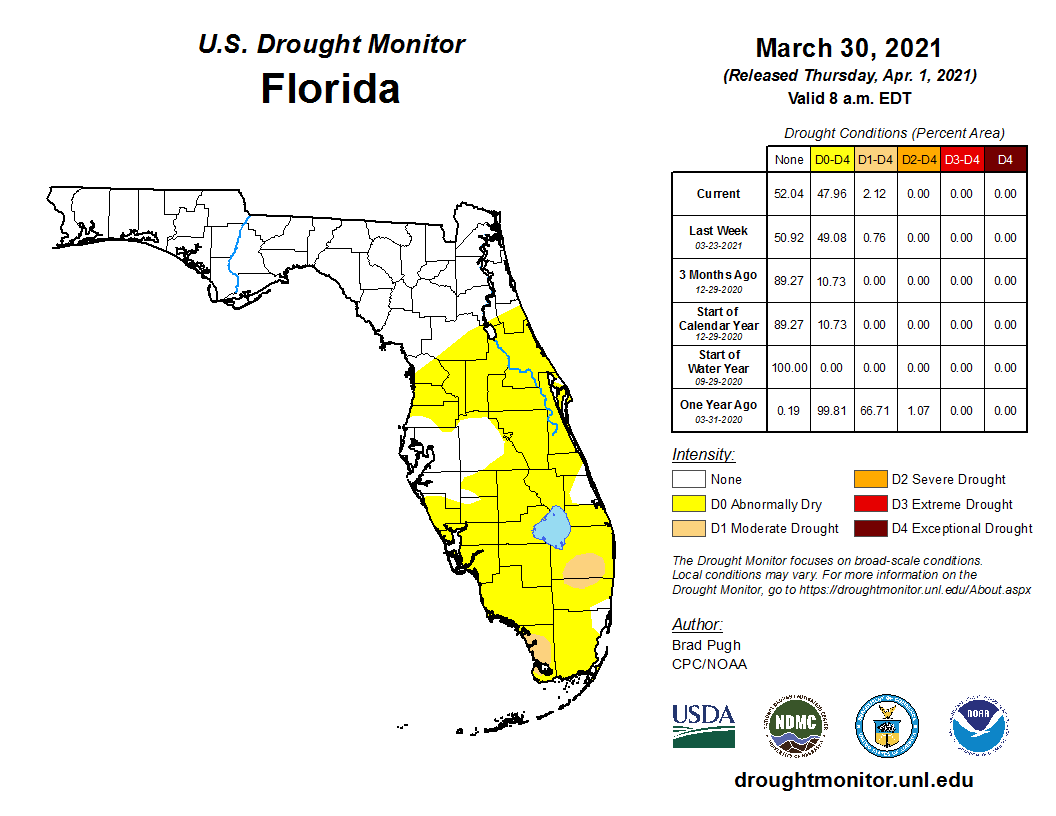
Agriculture-Related Impacts.
For the month of March, the Crop Progress - State Stories, produced monthly December through March, for Florida indicates that some pastures dried out by the end of the month due to warmer temperatures and a lack of rainfall. Cattle conditions remained mostly good during the month, and sugarcane harvesting continued. As temperatures rose during the month, Whiteflies and pest pressure were noted on vegetable crops in the southern part of the state. Many citrus fruits were harvested, including white and red grapefruit, Valencia oranges, and Honey, Tango and Royal tangerines. Field corn was planted and land was prepared for peanut and cotton crops in the Panhandle and northern parts of the state.
Appendix 1
Additional March departures from normal data for select Florida locations (Source: NWS).
| Station | Average Temperature (˚F) | Departure from Normal (˚F) | Total Rainfall (in.) | Departure from Normal (in.) |
| Gainesville | 64.9 | +2.6 | 3.24 | -1.09 |
| Sarasota | 69.1 | +2.5 | 1.84 | -2.02 |
| Melbourne | 69.7 | +3.8 | 0.87 | -2.41 |
| Fort Myers | 71.6 | +1.7 | 0.40 | -2.48 |
| West Palm Beach | 74.4 | +3.9 | 0.96 | -3.63 |
Appendix 2
Select daily record high maximum temperatures tied or broken during March (compiled from NOAA).
| Location | Date | Record (˚F) | Broken/Tied | Last |
| Clermont | 1 | 91 | Broken | 89 in 2017 |
| Sanford | 1 | 89 | Broken | 87 in 1997 |
| Lakeland | 1 | 88 | Broken | 86 in 1991 |
| Plant City | 2 | 89 | Tied | 89 in 2019 |
| Vero Beach | 17 | 89 | Broken | 87 in 1990 |
| Orlando | 17 | 89 | Broken | 88 in 2016 |
| Punta Gorda | 18 | 89 | Tied | 89 in 2015 |
| Fort Pierce | 19 | 90 | Tied | 90 in 1965 |
| Clermont | 26 | 94 | Broken | 90 in 1954 |
| Hastings | 26 | 87 | Broken | 86 in 2002 |
| Lisbon | 26 | 88 | Broken | 87 in 1965 |
| Plant City | 26 | 94 | Broken | 91 in 1974 |
| Sanford | 26 | 92 | Broken | 89 in 1974 |
| Gainesville | 26 | 89 | Broken | 87 in 2020 |
| Jacksonville | 26 | 90 | Broken | 88 in 1965 |
| Marianna | 27 | 88 | Tied | 88 in 2020 |
| Tampa | 27 | 90 | Broken | 89 in 2020 |
| Clermont | 28 | 94 | Broken | 91 in 2016 |
| West Palm Beach | 28 | 88 | Tied | 88 in 2016 |
| Pensacola | 28 | 86 | Broken | 84 in 2020 |
| Daytona Beach | 29 | 89 | Broken | 87 in 1961 |
| Stuart | 29 | 90 | Broken | 89 in 1996 |
| Tarpon Springs | 30 | 90 | Broken | 89 in 1997 |
| Tampa | 30 | 88 | Broken | 87 in 2020 |
| Naples | 31 | 90 | Broken | 88 in 2008 |
| Punta Gorda | 31 | 92 | Broken | 90 in 1981 |
Appendix 3
Select daily record high minimum temperatures tied or broken during March (compiled from NOAA).
| Location | Date | Record (˚F) | Broken/Tied | Last |
| Daytona Beach | 1 | 71 | Broken | 68 in 2003 |
| Hastings | 1 | 64 | Broken | 62 in 1998 |
| Melbourne | 1 | 69 | Tied | 69 in 1997 |
| Mountain Lake | 1 | 81 | Broken | 69 in 2003 |
| Daytona Beach | 1 | 69 | Broken | 66 in 2017 |
| Orlando | 1 | 72 | Broken | 68 in 2018 |
| Tampa | 1 | 71 | Broken | 70 in 2017 |
| Punta Gorda | 2 | 76 | Broken | 71 in 2007 |
| Lakeland | 2 | 69 | Tied | 69 in 1991 |
| Pensacola | 16 | 70 | Broken | 67 in 2016 |
| Marianna | 17 | 67 | Broken | 65 in 2002 |
| Pensacola | 17 | 72 | Broken | 69 in 1982 |
| Tallahassee | 17 | 67 | Broken | 66 in 2016 |
| Chipley | 18 | 71 | Broken | 67 in 1982 |
| Fort Lauderdale Beach | 18 | 74 | Tied | 74 in 2014 |
| Key West | 18 | 77 | Tied | 77 in 1986 |
| Orlando | 18 | 69 | Broken | 68 in 1943 |
| West Palm Beach | 18 | 74 | Broken | 73 in 2020 |
| Mountain Lake | 26 | 79 | Broken | 73 in 2015 |
| Perrine | 26 | 72 | Broken | 70 in 2016 |
| Marianna | 26 | 73 | Broken | 64 in 2017 |
| Daytona Beach | 26 | 70 | Broken | 67 in 1949 |
| West Palm Beach | 26 | 76 | Broken | 74 in 2005 |
| Orlando | 26 | 71 | Broken | 69 in 2020 |
| Pensacola | 26 | 72 | Broken | 68 in 2020 |
| Tallahassee | 26 | 69 | Broken | 66 in 2005 |
| Chipley | 27 | 72 | Broken | 67 in 1959 |
| Fort Lauderdale Beach | 27 | 75 | Tied | 75 in 2005 |
| Jasper | 27 | 66 | Broken | 64 in 2005 |
| Perry | 27 | 71 | Broken | 67 in 2011 |
| Wewahitchka | 27 | 69 | Broken | 67 in 1984 |
| Hastings | 29 | 67 | Broken | 65 in 2009 |
| Sanford | 29 | 70 | Broken | 69 in 2016 |
| Tampa | 29 | 73 | Broken | 72 in 2020 |
| Key West | 30 | 77 | Tied | 77 in 2020 |
| Vero Beach | 30 | 73 | Tied | 73 in 1990 |
| Fort Pierce | 31 | 75 | Broken | 73 in 1929 |
| Perrine | 31 | 73 | Broken | 71 in 2011 |
| Vero Beach | 31 | 74 | Broken | 72 in 1980 |
| Lakeland | 31 | 71 | Broken | 70 in 1975 |
Prepared by Florida Climate Center
The Florida State University
Tallahassee, FL
April Key Points:
- Temperatures were above normal across the Florida Peninsula and near or below normal across much of the northern part of the state.
- Rainfall was above normal across the state, except in parts of southern Florida.
- La Niña Advisory continued but weakened with an 80% chance for a transition to ENSO-neutral conditions during the next month or so.
- Strong storms swept through the South on April 9-10, with heavy rain, quarter to nearly golf ball-sized hail, and multiple reports of tornadoes.
- Abnormally dry conditions persisted across the southern Peninsula, with moderate drought across Monroe and parts of Collier counties.
Average temperatures in April were near or below normal across much of the Panhandle and northern parts of the state and above normal across southern Florida. Average temperature departures ranged from -1.3 ̊F in Jacksonville to +2.4 ̊F in Key West for the month (see Table 1 and Appendix 1 for select cities). There were several daily high maximum and high minimum temperature records set during the month, mostly across the Florida Peninsula (see Appendices 2 and 3).
Table 1. April average temperatures and departures from normal ( ̊F) for selected cities.
| Station | Mean Temperature | Departure from Normal |
| Pensacola | 67.0 | +0.4 |
| Tallahassee | 65.5 | -0.8 |
| Jacksonville | 65.7 | -1.3 |
| Orlando | 71.8 | +0.6 |
| Tampa | 73.9 | +1.9 |
| Miami | 77.4 | +1.6 |
| Key West | 78.8 | +2.4 |
Rainfall totals in April were above normal across most of the state but below normal in parts of south Florida (Figure 1). Monthly departures from normal ranged from -0.94 inches in Key West to +5.97 inches in Pensacola (Table 2 and Appendix 1). Hastings observed its third wettest April on record; Orlando had its fourth wettest April; and Pensacola had its fifth wettest April on record. Many daily precipitation records were also set. Pensacola recorded the highest daily rainfall amount during the month, which occurred on the 10th with 4.03 inches, beating its previous record of 2.61 inches on that day in 1959.
Table 2. April precipitation totals and departures from normal (inches) for selected cities.
| Station | Total Rainfall | Departure from Normal |
| Pensacola | 10.29 | +5.97 |
| Tallahassee | 3.51 | +0.45 |
| Jacksonville | 5.49 | +2.85 |
| Orlando | 6.34 | +3.66 |
| Tampa | 3.35 | +1.32 |
| Miami | 2.81 | -0.33 |
| Key West | 1.11 | -0.94 |
Figure 1. A graphical depiction of the monthly rainfall departure from normal (inches) for April (courtesy of NOAA, NWS).
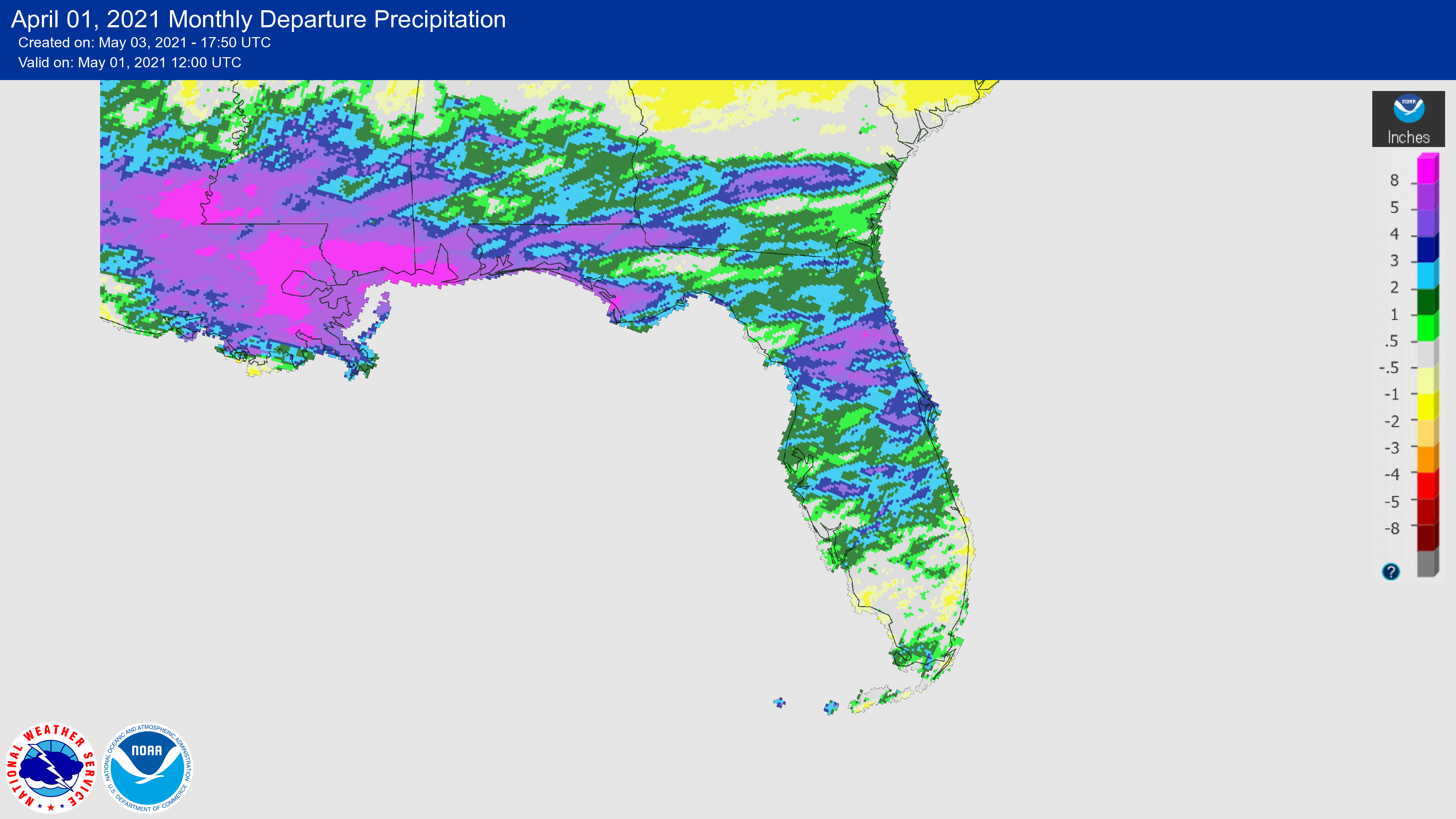
La Niña Advisory; Shifting to ENSO-Neutral.
La Niña conditions continued during April with below average sea surface temperatures over the tropical east-central to eastern Pacific Ocean. However, forecasters estimate a shift to ENSO-neutral conditions is likely in the next month or so (an ~80% chance during May-July). ENSO-neutral conditions are then expected to continue at least through the Northern Hemisphere summer.
Hazardous Weather Events in April.
According to the Local Storm Reports issued by the local National Weather Service offices serving Florida, there were 449 individual local reports of hazardous weather events recorded across the state during the month of April (see Table 4 for a breakdown by event type). Severe weather swept through the southern U.S. on April 9-10, resulting in at least 3 fatalities, damaging buildings, and leaving thousands without power in Florida. NWS confirmed 4 tornadoes in the Panhandle during that weekend, along with high winds and quarter to just under golf ball-sized hail. A wildfire was reported in Homestead on the 30th with no immediate threats or endangerments.
Table 4. Breakdown of storm reports submitted in Florida during the month of April (compiled from Iowa State University/Iowa Environmental Mesonet).
| Report Type | Number of Reports |
| Coastal Flood | 1 |
| Flash Flood | 19 |
| Marine Thunderstorm Wind | 64 |
| Non-Thunderstorm Wind Gust | 46 |
| Tornado/Waterspout/Funnel Cloud | 5/6/2 |
| Thunderstorm Wind Damage | 70 |
| Thunderstorm Wind Gust | 148 |
| Hail | 82 |
| Heavy Rain | 5 |
| Wildfire | 1 |
Drought-Related Impacts.
By the end of April 2021, abnormally dry conditions persisted across southern Florida. Moderate drought (D1) developed in southern Florida across Monroe County and parts of Collier and Miami-Dade counties. From early to mid-April, abnormally dry conditions existed across much of the Florida Peninsula. Moderate drought had developed across Monroe and Collier counties and stretching into Broward and Palm Beach counties. By the end of the month, however, moderate drought conditions were alleviated in Broward and Palm Beach counties. According to the U.S. Drought Monitor, 14 percent of the state was experiencing abnormally dry conditions (D0) and 4 percent was experiencing moderate drought (D1) by the end of the month.
As of April 30, the Lake Okeechobee water level was at 14.03 ft. above sea level (Feet-NGVD29), which is near to slightly above the average for this time of the year. At the first of the month, the water level was 14.44 ft. above sea level.
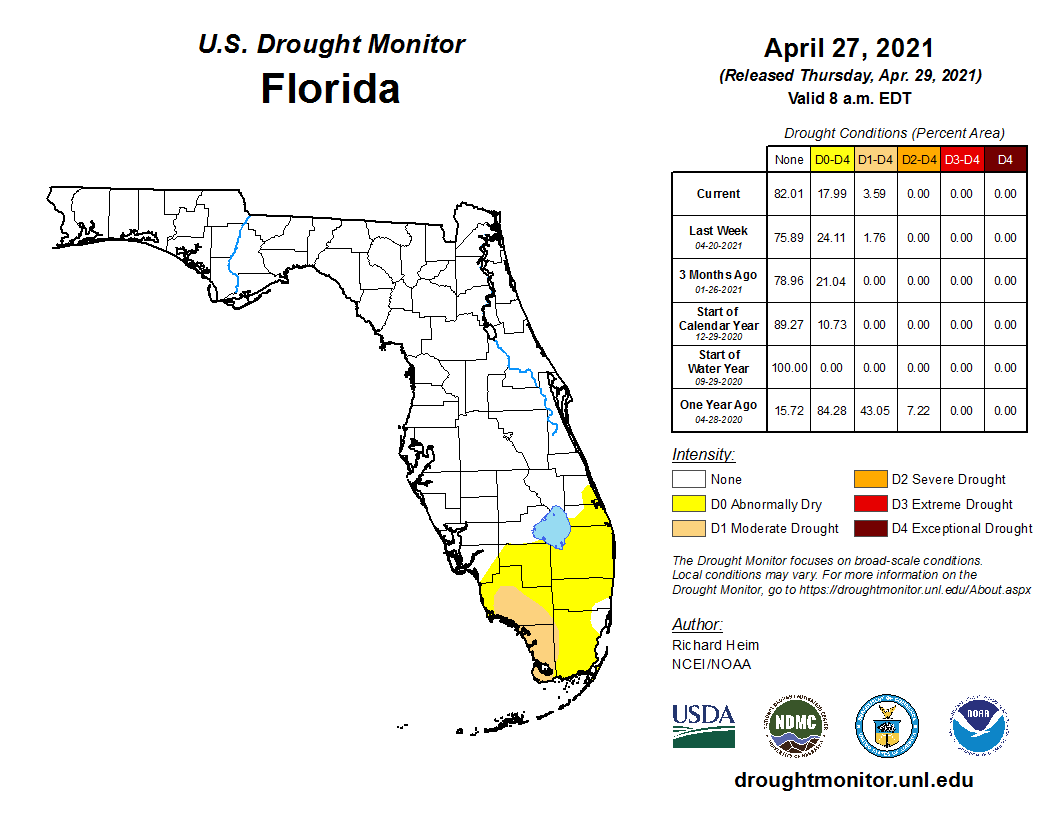
Agriculture-Related Impacts.
During mid-April, topsoil moisture levels were adequate for 67% of the state, short in 25%, and very short in 3%, while 5% of the state was in surplus. By the end of April, topsoil moisture levels were adequate in 57% of the state, short in 36%, and very short in 2% of the state; 5% of the state was in surplus. Most of the state had either fair (39%) or good (36%) pasture and range conditions by the end of the month. For more information, consult the weekly Crop Progress and Conditions report published by the USDA's National Agricultural Statistics Service.
Appendix 1
Additional April departures from normal data for select Florida locations (Source: NWS).
| Station | Average Temperature (˚F) | Departure from Normal (˚F) | Total Rainfall (in.) | Departure from Normal (in.) |
| Gainesville | 66.7 | -0.9 | 4.11 | +1.44 |
| Sarasota | 72.3 | +1.2 | 4.09 | +1.65 |
| Melbourne | 72.3 | +1.9 | 2.76 | +0.63 |
| Fort Myers | 75.3 | +1.5 | 3.73 | +1.55 |
| West Palm Beach | 76.4 | +2.6 | 2.88 | -0.78 |
Appendix 2
Select daily record high maximum temperatures tied or broken during April (compiled from NOAA).
| Location | Date | Record (˚F) | Broken/Tied | Last |
| Clermont | 1 | 93 | Broken | 92 in 2016 |
| Plant City | 1 | 93 | Broken | 92 in 1974 |
| Sanford | 1 | 91 | Tied | 91 in 1974 |
| Daytona Beach | 11 | 89 | Tied | 89 in 1935 |
| Crestview | 13 | 91 | Broken | 89 in 2001 |
| Tallahassee | 13 | 92 | Broken | 90 in 1981 |
| Miami | 17 | 90 | Tied | 90 in 2001 |
| Vero Beach | 17 | 91 | Broken | 90 in 2006 |
| Fort Lauderdale | 18 | 92 | Broken | 91 in 1924 |
| Fort Lauderdale Beach | 18 | 93 | Broken | 90 in 2001 |
| Vero Beach | 18 | 90 | Tied | 90 in 2006 |
| Miami | 19 | 92 | Tied | 92 in 1969 |
Appendix 3
Select daily record high minimum temperatures tied or broken during April (compiled from NOAA).
| Location | Date | Record (˚F) | Broken/Tied | Last |
| Sanford | 1 | 69 | Tied | 69 in 2002 |
| Mountain Lake | 12 | 77 | Broken | 73 in 2020 |
| Bradenton | 17 | 72 | Broken | 70 in 2015 |
| Venice | 17 | 74 | Broken | 73 in 1972 |
| Fort Myers | 17 | 72 | Broken | 71 in 1912 |
| Tampa | 17 | 75 | Broken | 74 in 1944 |
| Lakeland | 17 | 70 | Broken | 69 in 1994 |
| Bradenton | 18 | 74 | Broken | 70 in 2020 |
| Plant City | 18 | 73 | Tied | 73 in 2000 |
| Venice | 18 | 73 | Broken | 72 in 1978 |
| Punta Gorda | 19 | 76 | Broken | 71 in 1994 |
| Miles City | 19 | 72 | Broken | 68 in 2006 |
| Ochopee | 19 | 75 | Broken | 70 in 2019 |
| Fort Myers | 19 | 74 | Broken | 72 in 1982 |
Prepared by Florida Climate Center
The Florida State University
Tallahassee, FL
Average temperatures in January were near normal across much of the state. Most locations were within 2 ̊F from normal average temperatures, with most locations slightly above normal (see Table 1 and Appendix 1 for select cities). Departures from normal ranged from +2.4 ̊F in Pensacola to -0.2 ̊F in Key West. No temperature records were set during the month of January.
Table 1. January average temperatures and departures from normal ( ̊F) for selected cities.
| Station | Mean Temperature | Departure from Normal |
| Pensacola | 53.8 | +2.4 |
| Tallahassee | 52.6 | +1.4 |
| Jacksonville | 54.7 | +1.6 |
| Orlando | 60.3 | +0.1 |
| Tampa | 61.7 | +0.9 |
| Miami | 68.6 | +0.4 |
| Key West | 69.1 | -0.2 |
Rainfall totals in January were generally below average across the state. Monthly departures from normal ranged from -0.53 inches in Key West to -2.89 inches in Gainesville (Table 2 and Appendix 1). The central Panhandle in the Big Bend region was an exception, with rainfall departures in Tallahassee at +2.47 inches (Figure 1). There were no rainfall records set during the month of January.
Table 2. January precipitation totals and departures from normal (inches) for selected cities.
| Station | Total Rainfall | Departure from Normal |
| Pensacola | 2.78 | -1.85 |
| Tallahassee | 6.81 | +2.47 |
| Jacksonville | 1.97 | -1.33 |
| Orlando | 0.33 | -2.02 |
| Tampa | 0.82 | -1.41 |
| Miami | 0.50 | -1.12 |
| Key West | 1.51 | -0.53 |
Figure 1. A graphical depiction of the monthly rainfall departure from normal (inches) for January (courtesy of NOAA, NWS).
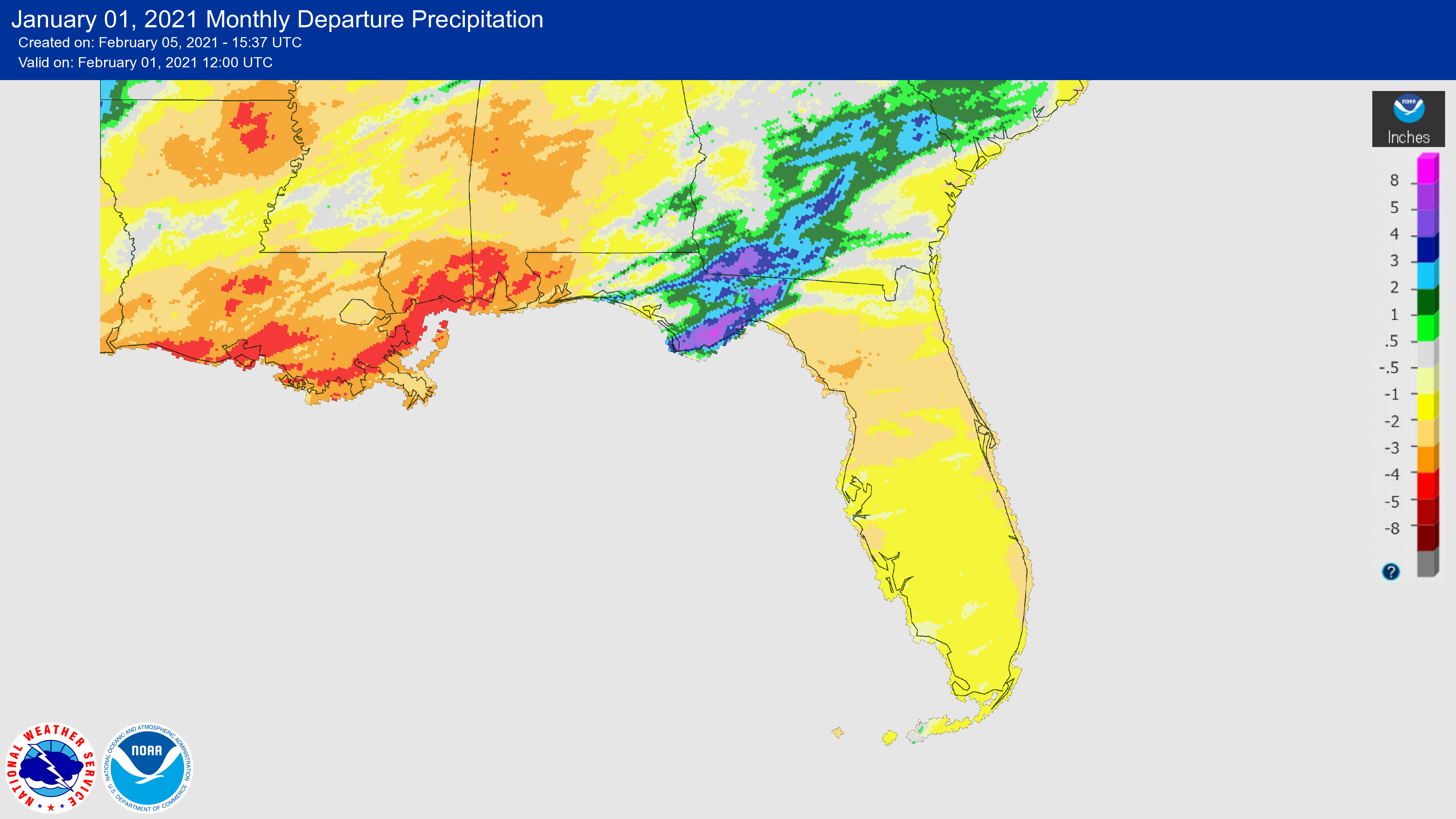
La Niña Conditions in the Pacific.
La Niña conditions are forecasted to continue through the Northern Hemisphere winter and early spring from January to March (~95% chance), with a possible transition to ENSO-neutral conditions during the spring (55% chance during April to June). As La Niña conditions persist, above-average temperatures and drier than average conditions are expected to continue across much of the southern tier of the U.S. over the next couple of months.
Hazardous Weather Events in January.
There were 57 individual local reports of hazardous weather events recorded in Florida during the month of January (see Table 4 for a breakdown by event type). A strong line of thunderstorms moved through central parts of the Panhandle on the 27th, with reports of tornadoes in Leon County around Tallahassee and the surrounding area. One tornado was reported at the Tallahassee airport, which knocked over one plane and damaged other planes, causing a temporary shutdown of the airport.
Table 4. Breakdown of storm reports submitted in Florida during the month of January (compiled from Iowa State University/Iowa Environmental Mesonet).
| Report Type | Number of Reports |
| Marine Thunderstorm Wind | 7 |
| Non-Thunderstorm Wind Damage | 0 |
| Non-Thunderstorm Wind Gust | 16 |
| Tornado/Waterspout/Funnel Cloud | 3/0/1 |
| Thunderstorm Wind Damage | 8 |
| Thunderstorm Wind Gust | 5 |
| Flood/Flash Flood | 2/2 |
| Heavy Rain | 13 |
Drought-Related Impacts.
Portions of the state experienced abnormally dry conditions in January; however, no areas experienced drought conditions. During January, abnormally dry conditions (D0) emerged in the extreme northwestern Panhandle region, while abnormally dry conditions expanded across the northern part of the peninsula, according to the U.S. Drought Monitor. Roughly 12% of the state was moderately dry in January. Dry conditions are expected to continue, and the seasonal drought outlook indicates that drought development is likely through the spring in parts of Florida.
As of January 31, the Lake Okeechobee water level was at 15.47 ft. above sea level (Feet-NGVD29), which is above average for this time of the year. At the first of the month, the water level was 15.81 ft. above sea level and slowly decreased throughout the month.
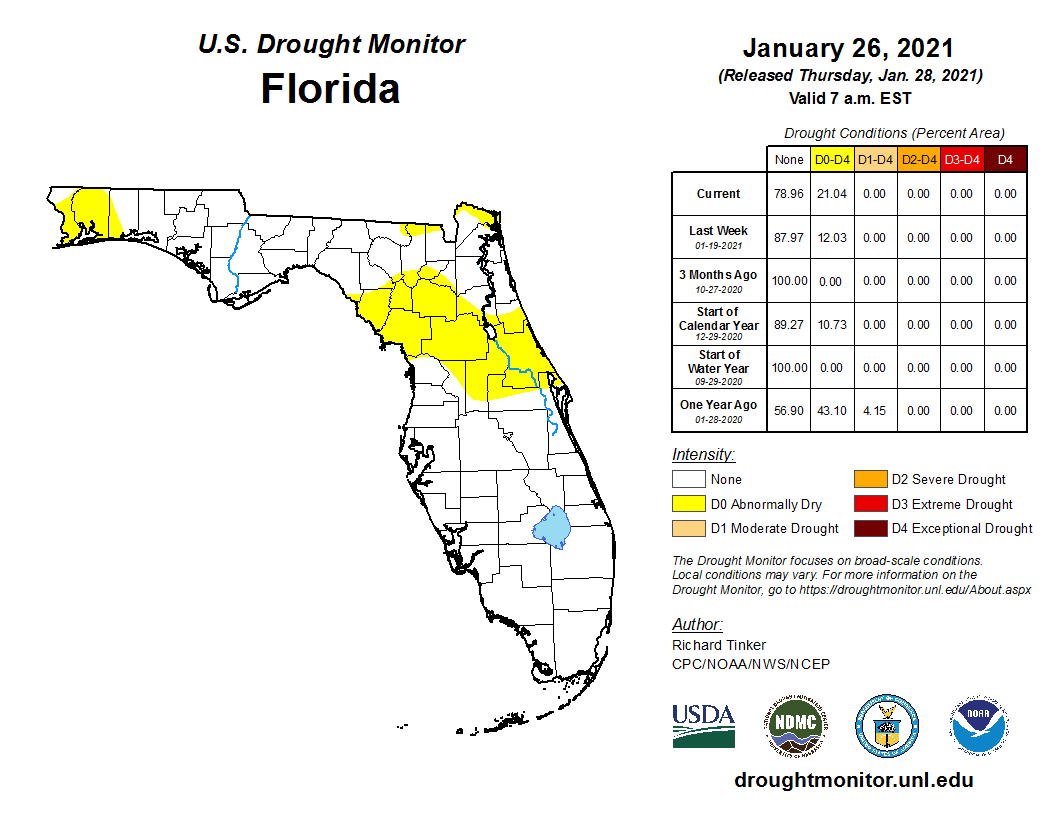
Agriculture-Related Impacts.
The weekly Crop Progress and Condition reports published by the USDA’s National Agricultural Statistics Service are produced during the growing season months only, from April to November. The Crop Progress - State Stories, produced monthly December through March, for Florida indicates that pasture conditions remained mostly fair to good throughout January. Cattle conditions also remained fairly good during the month. Despite cold temperatures during the third week of January, sugarcane planting and harvesting continued with no damages reported; however, disease in strawberries was noted late in the month. Wind and large temperature swings have led to weakening of watermelon seedlings in south Florida.
Appendix 1
Additional January departures from normal data for select Florida locations (Source: NWS).
| Station | Average Temperature (˚F) | Departure from Normal (˚F) | Total Rainfall (in.) | Departure from Normal (in.) |
| Gainesville | 55.1 | +0.8 | 0.44 | -2.89 |
| Sarasota | 63.0 | +1.6 | 0.70 | -1.79 |
| Melbourne | 61.6 | +1.3 | 0.04 | -2.23 |
| Fort Myers | 64.5 | +1.5 | 0.27 | -1.68 |
Prepared by Florida Climate Center
The Florida State University
Tallahassee, FL
Average temperatures continued to be well above average across the state in November. Most places in Florida were warm throughout the month with average temperatures above normal, much like the contiguous U.S. which had its 4th warmest November on record. Departures from normal across the state ranged from +1.4 ̊F in Key West to over +6 ̊F in the Panhandle (Table 1 and Appendix 1). West Palm Beach observed its second warmest November on record (1888-2020). Both maximum and minimum temperatures were well above average during the month across the state as well. Many high daily minimum temperature records were set during the month; Tampa observed its highest daily minimum temperature on record at 78 ̊F on the 10th (1890-2020). Additionally, many record daily high maximum temperatures were set, particularly during the middle of the month (Appendix 2).
Table 1. November average temperatures and departures from normal ( ̊F) for selected cities.
| Station | Mean Temperature | Departure from Normal |
| Pensacola | 67.2 | +6.5 |
| Tallahassee | 66.6 | +5.8 |
| Jacksonville | 67.3 | +4.7 |
| Orlando | 73.5 | +5.0 |
| Tampa | 74.6 | +5.2 |
| Miami | 77.4 | +2.2 |
| Key West | 77.8 | +1.4 |
Rainfall totals in November were mixed, with wetter than normal conditions in the southern half of the state and drier than normal conditions in the northwestern and Panhandle regions. The Panhandle observed monthly precipitation departures from normal ranging from -3.5 inches in Crestview to -1.3 inches in Perry. Conversely, the Peninsula experienced wetter conditions during the month, with departures from normal ranging from +1.6 inches in Orlando to over +11 inches in Fort Lauderdale (Table 2 and Figure 1). From November 8-12th, Tropical Storm Eta impacted portions of west-central and southern Florida, contributing between 5 and 10 inches of rainfall in these areas. On the 11th, Sarasota-Bradenton observed its wettest November day on record (since 1911) with 6.41 inches of rainfall. Additionally, Fort Lauderdale, Miami, Homestead, and Sarasota all experienced their wettest Novembers on record.
Table 2. November precipitation totals and departures from normal (inches) for selected cities.
| Station | Total Rainfall | Departure from Normal |
| Pensacola | 2.20 | -2.53 |
| Tallahassee | 3.63 | +0.13 |
| Jacksonville | 1.81 | -0.31 |
| Orlando | 5.24 | +3.06 |
| Tampa | 5.40 | +3.86 |
| Miami | 9.61 | +6.34 |
| Key West | 7.52 | +5.22 |
Figure 1. A graphical depiction of the monthly rainfall departure from normal (inches) for November 2020 (courtesy of NOAA, NWS).
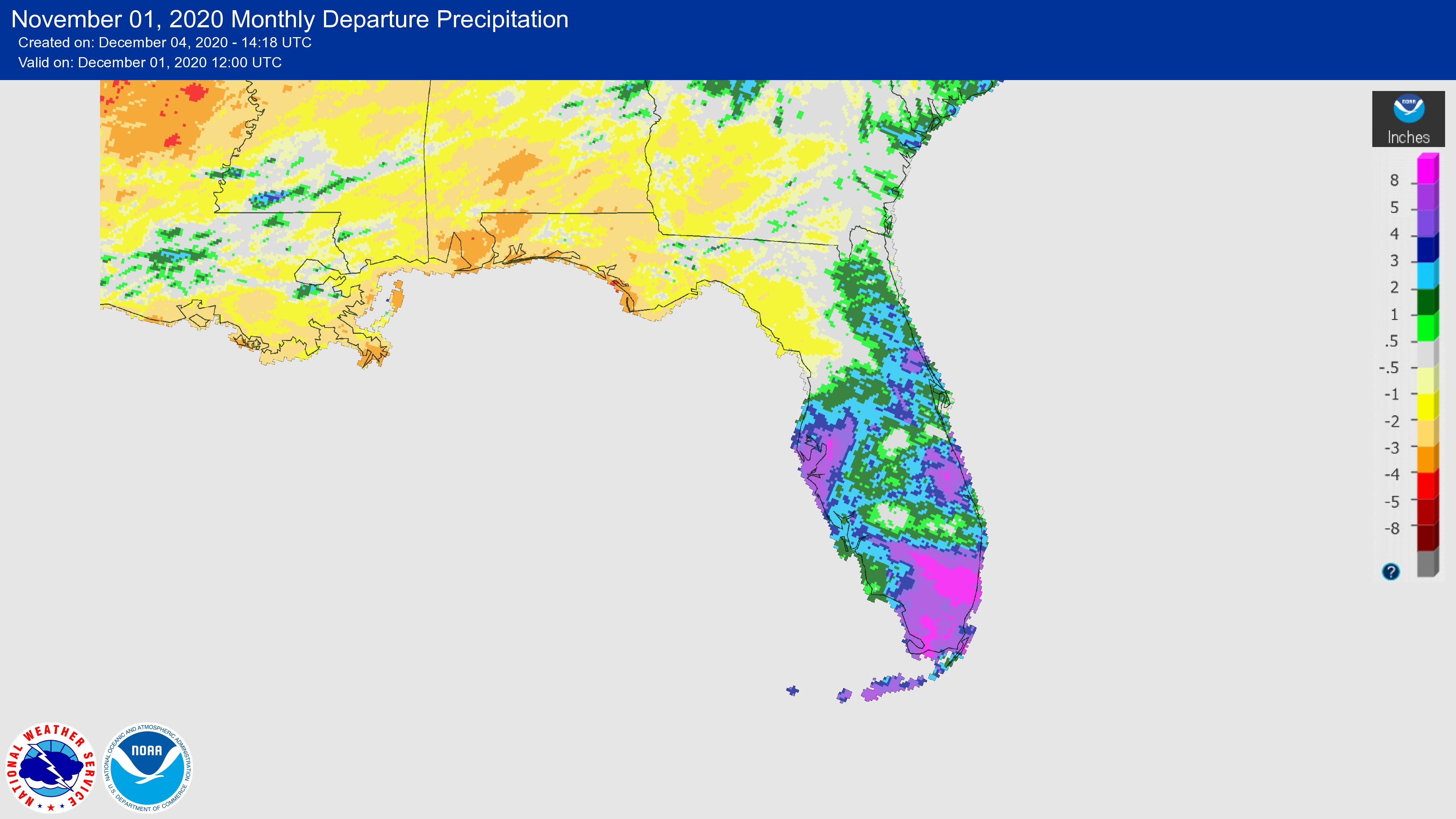
Strong La Niña Conditions in the Pacific.
La Niña strengthened in the tropical Pacific in October, as indicated by sea surface temperature indices in the two westernmost Niño regions. La Niña will continue through the winter (100% chance) with conditions expected to remain strong. La Niña conditions are expected to continue into spring (~65% chance during March-May). La Niña winters tend to favor above-average temperatures and dry conditions across the southern tier of the U.S.
Hazardous Weather Events in November.
There were 676 individual local reports of hazardous weather events recorded in Florida during the month of November (see Table 4 for a breakdown by event type). Tropical Storm Eta made initial landfall on Lower Matecumbe Key, FL on the 8th with maximum sustained winds of 65 mph and several reports of wind gusts exceeding 50 mph. The storm made a second landfall on the 12th near Cedar Key, FL. The storm impacted central and southern parts of the Florida Peninsula, with numerous reports of flooded roadways and homes as the storm moved north and east across the state. With the close of November, the 2020 record-breaking hurricane season has officially ended. Tropical Storm Eta was the 12th named storm to make landfall in the U.S. during this season, which broke the previous annual record of 9 landfalls set in 1916.
Table 4. Breakdown of storm reports submitted in Florida during the month of November (compiled from Iowa State University/Iowa Environmental Mesonet).
| Report Type | Number of Reports |
| Coastal Flood | 3 |
| Flash Flood | 12 |
| Flood | 36 |
| Heavy Rain | 20 |
| Marine Thunderstorm Wind | 251 |
| Non-Thunderstorm Wind Damage | 1 |
| Non-Thunderstorm Wind Gust | 121 |
| Tornado/Waterspout/Funnel Cloud | 4/1/1 |
| Thunderstorm Wind Damage | 14 |
| Thunderstorm Wind Gust | 54 |
| Hail | 2 |
| Rip Current | 1 |
| Storm Surge | 16 | Tropical Storm | 139 |
Drought-Related Impacts.
During the month of November, drought did not impact any part of the state, according to the U.S. Drought Monitor. Abnormally dry conditions (D0) affected a small area in the extreme northeastern most section of the state expanding into parts of Georgia. Continuing La Niña conditions are expected to result in a dry winter pattern across the Southeast U.S. region.
As of November 30, the Lake Okeechobee water level was at 16.12 ft. above sea level (Feet-NGVD29), which is above average for this time of the year. At the beginning of November, the water level was at 16.26 ft. above sea level.
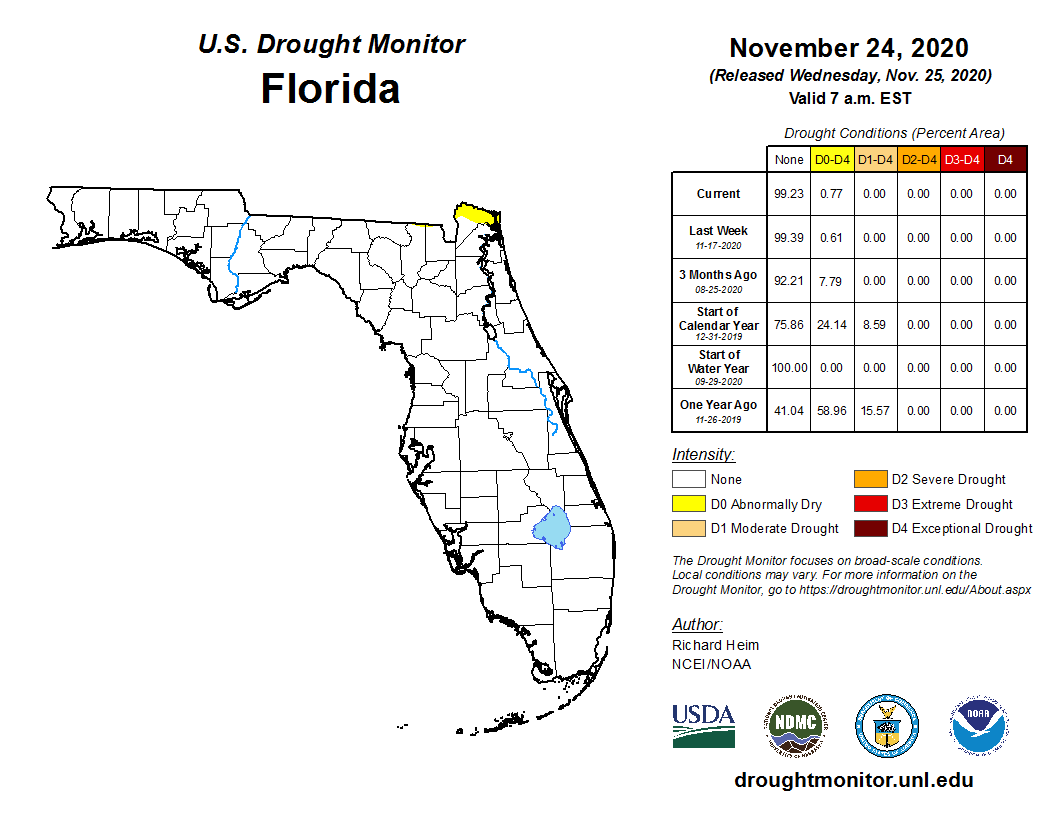
Agriculture-Related Impacts.
In mid-November, topsoil moisture levels were adequate in 53% of the state, short in 9% of the state, and 38% of the state had a surplus. By the end of November, topsoil moisture levels were adequate in 66% of the state, short in 10%, and 24% of the state was in surplus. For more information, consult the weekly Crop Progress and Condition reports published by the USDA’s National Agricultural Statistics Service.
Appendix 1
Additional November departures from normal data for select Florida locations (Source: NWS).
| Station | Average Temperature (˚F) | Departure from Normal (˚F) | Total Rainfall (in.) | Departure from Normal (in.) |
| Gainesville | 67.5 | +4.7 | 2.41 | +0.35 |
| Sarasota | 74.7 | +5.5 | 7.62 | +5.69 |
| Melbourne | 73.2 | +4.2 | 4.41 | +1.53 |
| Fort Myers | 75.8 | +4.2 | 4.21 | +2.29 |
Appendix 2
Select daily maximum temperature records tied or broken during November (compiled from NOAA).
| Location | Date | Record (˚F) | Broken/Tied | Last |
| Miles City | 1 | 94 | Broken | 93 in 2015 |
| Key West | 1 | 96 | Broken | 89 in 2019 |
| Fort Lauderdale | 2 | 89 | Broken | 88 in 2019 |
| Key West | 5 | 90 | Broken | 88 in 2019 |
| Pensacola | 8 | 85 | Broken | 82 in 2017 |
| Key West | 9 | 90 | Broken | 88 in 1993 |
| Pensacola | 9 | 85 | Broken | 83 in 1986 |
| Bradenton | 10 | 87 | Tied | 87 in 2018 |
| Tarpon Springs | 10 | 90 | Broken | 89 in 1946 |
| Gainesville | 10 | 84 | Tied | 84 in 1998 |
| Tampa | 10 | 89 | Broken | 87 in 1986 |
| Key West | 10 | 89 | Broken | 88 in 2018 |
| Crestview | 10 | 85 | Broken | 83 in 2002 |
| Pensacola | 10 | 84 | Broken | 82 in 2002 |
| Tallahassee | 10 | 87 | Tied | 87 in 1986 |
| Niceville | 11 | 83 | Broken | 81 in 2018 |
| Marianna | 11 | 86 | Broken | 82 in 2010 |
| Crestview | 11 | 86 | Broken | 82 in 2010 |
| Pensacola | 11 | 87 | Broken | 82 in 2006 |
| Key West | 12 | 94 | Broken | 88 in 2018 |
| Miami | 14 | 86 | Tied | 86 in 2018 |
| Key West | 14 | 93 | Broken | 88 in 2018 |
| Punta Gorda | 15 | 89 | Broken | 88 in 2011 |
| Key West | 15 | 94 | Broken | 90 in 2007 |
| Pensacola | 15 | 85 | Broken | 84 in 1951 |
| Hastings | 16 | 85 | Tied | 85 in 1993 |
| Niceville | 16 | 85 | Broken | 81 in 1980 |
| Key West | 16 | 95 | Broken | 86 in 1993 |
| Perrine | 17 | 86 | Broken | 85 in 2010 |
| Key West | 17 | 90 | Broken | 87 in 1988 |
| Key West | 19 | 87 | Broken | 86 in 2018 |
| Key West | 20 | 92 | Broken | 86 in 1976 |
| Key West | 21 | 90 | Broken | 86 in 1994 |
| Key West | 22 | 91 | Broken | 85 in 1998 |
| Key West | 23 | 87 | Broken | 85 in 1986 |
| Tallahassee | 26 | 83 | Broken | 82 in 1967 |
| Gainesville | 27 | 82 | Tied | 82 in 1988 |
| Key West | 27 | 93 | Broken | 86 in 2019 |
| Key West | 28 | 94 | Broken | 86 in 1994 |
| Key West | 29 | 94 | Broken | 86 in 1994 |
| Key West | 30 | 89 | Broken | 86 in 1994 |

